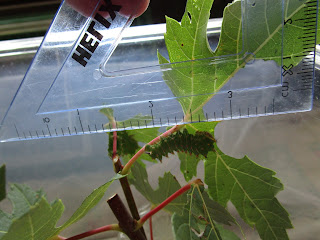An adult Polyhemus moth lives about 4 days. Their entire life cycle is approximately a year in length. About 10 days as eggs, 5 to 6 weeks in several larvae stages, and the rest of that time is spent enclosed in their cocoon. They enclose (emerge) and live their few days looking for a mate. They don't eat in that time period. These moths are actually fairly common in the PNW. I was rather surprised to find out how common!! This page is a fairly comprehensive in a nutshell story of their life cycle. Here in Eastern Oregon, there is a company out of Pendleton who raises their larvae on willow and even chokecherry, I used a tiny maple that almost didn't survive being harvested! The company is called Sagebrush Butterflies and this link should go to their FB page. They also have a website.
On July 20, 2021, Jonathan brought home a very large moth that was dropping eggs. Which is what these night birds do. They exist to lay eggs and if the female doesn't mate before her death, she will lay infertile eggs. This lady was in pretty rough shape after being found on cement near a light where Jon works, but she still gave us several eggs. I was thankful we had a mesh enclosure for her, but the eggs were quickly moved into another spot less easy for the young to escape from. Many many people have chronicled their own journey with these particular silk moths. You can find their stories on blogs and on YouTube. This is my saga with different images and a longer write up than some of the others. I used my little point and shoot for most of the images. I'll add some of Jon's photos, too. This online journey is in 6 parts. Each section has a bit about how to raise them. Part 5, I think, has the most information on that! Hope you enjoy this fun saga!
The moth was identified as a female Polyphemus moth. The moth is named after a Cyclops in Greek mythology. Oregon has only two giant silk moths, I believe. They are Cecropia, and Polyphemus. The former has little moon like shapes on the wings and the Polyphemus has the eye spots. The eggs cannot be identified as fertile or infertile until they hatch or not. People have theories, but the eggs are best left to come to fruition on their own!
August 22 and August 26, you can see how much larger they were getting. The 27th, they entered their second instar stage. You can see the little bunched up bit of the old skin or shed.
August 29, it turned out I had 3 instars left. There had been 4, but I somehow lost one when changing out the worn out leaves. I was sad and thankful at the same time. These guys really could eat!!!! Charlie and Alpha are the larger ones and Pee Wee was the smallest. Pee Wee was actually quite a bit smaller and I'm not sure why. It was also behind by a day. Measuring them to check growth was a bit of a chore. I absolutely DETEST crawly things on me. I may have refused to touch these fascinating creatures, but I did feed and care for them. I used coins, toothpicks, rulers, and fingers to measure the three. The 29th was the coin in this series, and the last two are August 30 and 31. Am betting that last one is Pee Wee.












No comments:
Post a Comment